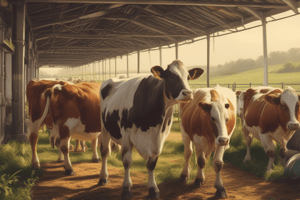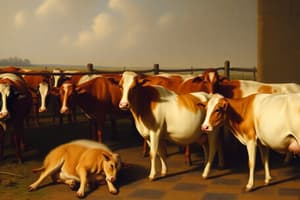Podcast
Questions and Answers
What is the primary objective of genetic selection in dairy farming?
What is the primary objective of genetic selection in dairy farming?
- To reduce disease resistance
- To identify superior breeding stock (correct)
- To increase the growth rate of calves
- To produce more milk
What is the main purpose of record keeping in dairy farming?
What is the main purpose of record keeping in dairy farming?
- To optimize feed sources and nutrition
- To improve housing and facilities management
- To track breeding and calving data (correct)
- To monitor milk production levels
Which nutrient is essential for dairy cattle, particularly during lactation?
Which nutrient is essential for dairy cattle, particularly during lactation?
- Protein
- Energy (correct)
- Minerals
- Fiber
What is the primary advantage of using a total mixed ration (TMR) in dairy cattle feeding?
What is the primary advantage of using a total mixed ration (TMR) in dairy cattle feeding?
Which breeding system involves the use of artificial insemination?
Which breeding system involves the use of artificial insemination?
What is the primary goal of nutritional management in dairy farming?
What is the primary goal of nutritional management in dairy farming?
What is the primary goal of dairy production?
What is the primary goal of dairy production?
What is a key component of ration formulation in dairy nutrition?
What is a key component of ration formulation in dairy nutrition?
What is a crucial aspect of disease prevention in dairy herds?
What is a crucial aspect of disease prevention in dairy herds?
What is an important factor in maintaining milk quality?
What is an important factor in maintaining milk quality?
What is a key consideration in facility design for dairy farms?
What is a key consideration in facility design for dairy farms?
What is an important aspect of health and disease management in dairy herds?
What is an important aspect of health and disease management in dairy herds?
Flashcards
Genetic Selection
Genetic Selection
Selecting animals with desired traits using genetic evaluation and testing.
Natural service
Natural service
Mating using a bull.
Artificial insemination (AI)
Artificial insemination (AI)
Introducing semen into the female reproductive tract, without the physical presence of a male.
Embryo transfer (ET)
Embryo transfer (ET)
Signup and view all the flashcards
Nutrient Requirements
Nutrient Requirements
Signup and view all the flashcards
Forages
Forages
Signup and view all the flashcards
Grains
Grains
Signup and view all the flashcards
Concentrates
Concentrates
Signup and view all the flashcards
Disease Prevention
Disease Prevention
Signup and view all the flashcards
Isolation
Isolation
Signup and view all the flashcards
Disease Diagnosis
Disease Diagnosis
Signup and view all the flashcards
Milking Techniques
Milking Techniques
Signup and view all the flashcards
Study Notes
Breeding and Genetics
- Breeding Objectives:
- Improve milk production and quality
- Enhance fertility and reproductive performance
- Increase disease resistance and longevity
- Optimize growth rate and body condition
- Genetic Selection:
- Select for desirable traits using genetic testing and evaluation
- Use genetic markers to identify superior breeding stock
- Consider crossbreeding to improve hybrid vigor
- Mating Systems:
- Natural service (bull breeding)
- Artificial insemination (AI)
- Embryo transfer (ET)
- Record Keeping:
- Accurate and detailed records of breeding, calving, and milk production
- Use of farm management software and data analysis tools
Nutrition and Feeding
- Nutrient Requirements:
- Energy, protein, fiber, vitamins, and minerals
- Variations in nutrient requirements based on age, stage of lactation, and production level
- Feed Sources:
- Forages (hay, silage, pasture)
- Grains (corn, barley, oats)
- Concentrates (protein supplements, minerals)
- By-products (brewer's grain, citrus pulp)
- Feeding Strategies:
- Total mixed ration (TMR) vs. component feeding
- Dry matter intake (DMI) and ration formulation
- Feeding frequency and management
- Nutritional Disorders:
- Acidosis, ketosis, and other metabolic disorders
- Mineral deficiencies and toxicities
Health and Disease Management
- Disease Prevention:
- Vaccination programs
- Parasite control (internal and external)
- Biosecurity measures (cleanliness, sanitation, isolation)
- Disease Diagnosis:
- Clinical signs and symptoms
- Laboratory testing (blood, milk, fecal samples)
- Physical examination and palpation
- Disease Treatment:
- Antibiotic therapy
- Anti-inflammatory and pain management
- Supportive care (fluid therapy, nutrition)
- Herdcare and Monitoring:
- Regular health checks and monitoring
- Data analysis and record keeping
Milking and Dairy Production
- Milking Techniques:
- Proper milking procedures and sanitation
- Machine milking vs. hand milking
- Milking frequency and duration
- Milk Quality:
- Somatic cell count (SCC) and bacterial counts
- Milk fat, protein, and lactose content
- Milk processing and handling
- Dairy Production Goals:
- Optimize milk yield and quality
- Improve milk fat and protein content
- Enhance milk processing and manufacturing
- Milk Marketing and Sales:
- Market trends and demand
- Milk pricing and contracts
- Product diversification and added value
Housing and Facilities Management
- Housing Systems:
- Free-stall barns
- Tie-stall barns
- Bedded packs and mattresses
- Outdoor and grazing systems
- Facility Design:
- Cow comfort and welfare
- Ventilation, lighting, and temperature control
- Manure management and handling
- Equipment and Maintenance:
- Milking equipment and sanitation
- Feed and water delivery systems
- Regular maintenance and repair schedules
- Environmental Impact:
- Manure and nutrient management
- Water conservation and quality
- Odor and air quality control
Studying That Suits You
Use AI to generate personalized quizzes and flashcards to suit your learning preferences.




